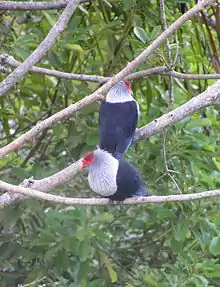Blue pigeon
The blue pigeons are a genus Alectroenas of birds in the dove and pigeon family Columbidae. They are native to islands in the western Indian Ocean.
| Blue pigeon | |
|---|---|
 | |
| Seychelles blue pigeon | |
| Scientific classification | |
| Kingdom: | Animalia |
| Phylum: | Chordata |
| Class: | Aves |
| Order: | Columbiformes |
| Family: | Columbidae |
| Subfamily: | Treroninae |
| Genus: | Alectroenas G.R. Gray, 1840 |
| Species | |
|
see text | |
Taxonomy and evolution
The genus Alectroenas was introduced in 1840 by the English zoologist George Robert Gray with the Mauritius blue pigeon (Alectroenas nitidissimus) as the type species.[1][2] The genus name combines the Ancient Greek alektruōn meaning "domestic cock" and oinas meaning "pigeon".[3]
The Alectroenas blue pigeons are closely interrelated and occur widely throughout islands in the western Indian Ocean. They are allopatric and can therefore be regarded as a superspecies.[4] There are three extant species; the Madagascan blue pigeon, the Comoros blue pigeon, and the Seychelles blue pigeon.[5] The three Mascarene islands were home to one species each, which are all extinct; the Mauritius blue pigeon, the Rodrigues blue pigeon, and the Réunion blue pigeon.[6] The blue pigeons perhaps colonised the Mascarenes, the Seychelles or a now submerged hot spot island by "island hopping" and evolved into a distinct genus there before reaching Madagascar.[7] Their closest genetic relative is the cloven-feathered dove, Drepanoptila holosericea, of New Caledonia, which they separated from 8–9 million years ago.[8] Their ancestral group appears to be the fruit doves (Ptilinopus) of Southeast Asia and Oceania.[9]
The genus contains four extant or recently extinct species:[10]
- † Mauritius blue pigeon (Alectroenas nitidissimus) extinct
- Madagascan blue pigeon (Alectroenas madagascariensis)
- Comoros blue pigeon (Alectroenas sganzini)
- Seychelles blue pigeon (Alectroenas pulcherrimus)
Two species that became extinct in prehistoric times may have belonged to this genus:
- † Rodrigues blue pigeon (Alectroenas payandeei)
- † Réunion blue pigeon (Alectroenas sp.)
The Rodrigues pigeon (Nesoenas rodericana), now extinct, was once assigned to the genus Alectroenas, but this is now believed to be erroneous. In reality, it probably belongs to an undescribed genus, as the sternum's shape is very dissimilar in its details to that of Alectroenas or Columba, and indeed to any other living genus of pigeons and doves. It is most similar to that of the Gallicolumba ground doves or to a miniature version of the sternum of a Ducula imperial pigeon.
Description
Compared to other pigeons, the blue pigeons are medium to large, stocky, have comparatively long wings and tails. They all have distinct mobile hackles on the head and neck. The tibiotarsus is comparatively long and the tarsometatarsus short.[11]
References
- Gray, George Robert (1840). A List of the Genera of Birds : with an Indication of the Typical Species of Each Genus. London: R. and J.E. Taylor. p. 58.
- Peters, James Lee, ed. (1937). Check-List of Birds of the World. Volume 3. Cambridge, Massachusetts: Harvard University Press. p. 40.
- Jobling, James A. (2010). The Helm Dictionary of Scientific Bird Names. London: Christopher Helm. p. 41. ISBN 978-1-4081-2501-4.
- Goodwin, D. 1983, Pigeons and Doves of the World, Cornell University Press, Ithaca, New York.
- Shelley, G. E. (1883). "On the Columbidae of the Ethiopian Region". Ibis. 5th series. 1 (3): 258–331. doi:10.1111/j.1474-919X.1883.tb07172.x.
- Hume, J. P.; Walters, M. (2012). Extinct Birds. London: A & C Black. pp. 134–136. ISBN 978-1-4081-5725-1.
- Cheke, A. S.; Hume, J. P. (2008). Lost Land of the Dodo: an Ecological History of Mauritius, Réunion & Rodrigues. New Haven and London: T. & A. D. Poyser. pp. 22–115. ISBN 978-0-7136-6544-4.
- Pereira, S. L.; Johnson, K. P.; Clayton, D. H.; Baker, A. J. (2007). "Mitochondrial and nuclear DNA sequences support a Cretaceous origin of Columbiformes and a dispersal-driven radiation in the Paleogene". Systematic Biology. 56 (4): 656–672. doi:10.1080/10635150701549672.
- Shapiro, B.; Sibthorpe, D.; Rambaut, A.; Austin, J.; Wragg, G. M.; Bininda-Emonds, O. R. P.; Lee, P. L. M.; Cooper, A. (2002). "Flight of the Dodo" (PDF). Science. 295 (5560): 1683. doi:10.1126/science.295.5560.1683. Supplementary information (HTML abstract) Free PDF Supplementary information
- Gill, Frank; Donsker, David; Rasmussen, Pamela, eds. (2020). "Pigeons". IOC World Bird List Version 10.1. International Ornithologists' Union. Retrieved 11 March 2020.
- Hume, J.P. (2011). "Systematics, morphology, and ecology of pigeons and doves (Aves: Columbidae) of the Mascarene Islands, with three new species". Zootaxa. 3124 (1): 1–62. doi:10.11646/zootaxa.3124.1.1. First page